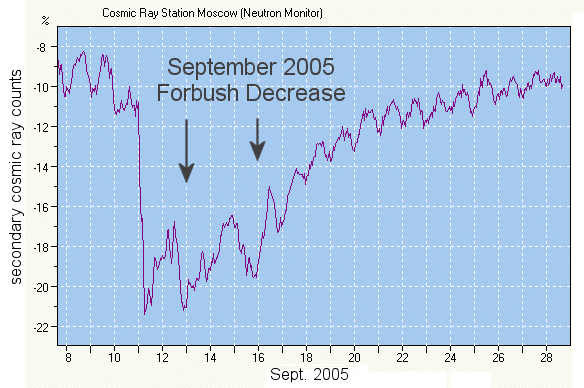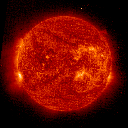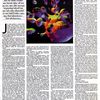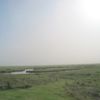Laugardagur, 1. ágúst 2009
Ný grein Henriks Svensmark um loftslagsbreytingar af völdum sólar og geimgeisla birt í Geophysical Research Letters í dag 1. ágúst...
Vegna þeirra fjölmörgu sem áhuga hafa á kenningu Henriks Svensmark um eðli loftslagsbreytinga þá skal bent á grein sem var að birtast í dag í hinu virta tímariti Geophysical Research Letters sem gefið er út af American Geophysical Union.
Kynning á kenningunni er hér: Byltingarkennd kenning dansks vísindamanns skekur vísindaheiminn.
Sjá einnig frétt af tilrauninni miklu hjá CERN
"Mikil virkni sólar -> mikill sólvindur -> minni geimgeislar -> minna um ský -> minna endurkast -> hærra hitastig"
"Forbush Descrease" sem fjallað er um í greininni er skyndileg minnkun geimgeisla eftir öflug sólgos. Greinin fjallar því um skammtímaáhrif sem ekki hafa nein marktæk áhrif á breytingar á hitastigi lofthjúpsins, en samt sem áður má líta á "Forbush Decrease" áhrifin sem kærkomið prufumerki sem gerir kleyft að rannsaka áhrif geimgeisla á skýin, og vætanlega þar með áhrif á hlýnun eða kólnun jarðar.
Sjá læsilega og fróðlega grein NASA um "Forbsh Decrease" hér (Who is afraid of a solar flare?).
Úrdrátt (abstract) má lesa hér: http://www.agu.org/pubs/crossref/2009/2009GL038429.shtml
Cosmic ray decreases affect atmospheric aerosols and clouds
Henrik Svensmark
National Space Institute, Technical University of Denmark, Copenhagen, Denmark
Torsten Bondo
National Space Institute, Technical University of Denmark, Copenhagen, Denmark
Jacob Svensmark
National Space Institute, Technical University of Denmark, Copenhagen, Denmark
Close passages of coronal mass ejections from the sun are signaled at the Earth's surface by Forbush decreases in cosmic ray counts. We find that low clouds contain less liquid water following Forbush decreases, and for the most influential events the liquid water in the oceanic atmosphere can diminish by as much as 7%. Cloud water content as gauged by the Special Sensor Microwave/Imager (SSM/I) reaches a minimum ≈7 days after the Forbush minimum in cosmic rays, and so does the fraction of low clouds seen by the Moderate Resolution Imaging Spectroradiometer (MODIS) and in the International Satellite Cloud Climate Project (ISCCP). Parallel observations by the aerosol robotic network AERONET reveal falls in the relative abundance of fine aerosol particles which, in normal circumstances, could have evolved into cloud condensation nuclei. Thus a link between the sun, cosmic rays, aerosols, and liquid-water clouds appears to exist on a global scale.
Received 31 March 2009; accepted 17 June 2009; published 1 August 2009.
Citation: Svensmark, H., T. Bondo, and J. Svensmark (2009), Cosmic ray decreases affect atmospheric aerosols and clouds, Geophys. Res. Lett., 36, L15101, doi:10.1029/2009GL038429.
Og svo splunkuný fréttatilkynning:
Cosmic meddling with the clouds by seven-day magic
29 July 2009 Technical University of Denmark (DTU)
Billions of tonnes of water droplets vanish from the atmosphere, as if by magic, in events that reveal in detail how the Sun and the stars control our everyday clouds. Researchers of the National Space Institute in the Technical University of Denmark (DTU) have traced the consequences of eruptions on the Sun that screen the Earth from some of the cosmic rays - the energetic particles raining down on our planet from exploded stars."The Sun makes fantastic natural experiments that allow us to test our ideas about its effects on the climate," says Prof. Henrik Svensmark, lead author of a report newly published in Geophysical Research Letters. When solar explosions interfere with the cosmic rays there is a temporary shortage of small aerosols, chemical specks in the air that normally grow until water vapour can condense on them, so seeding the liquid water droplets of low-level clouds. Because of the shortage, clouds over the ocean can lose as much as 7 per cent of their liquid water within seven or eight days of the cosmic-ray minimum.
"A link between the Sun, cosmic rays, aerosols, and liquid-water clouds appears to exist on a global scale," the report concludes. This research, to which Torsten Bondo and Jacob Svensmark contributed, validates 13 years of discoveries that point to a key role for cosmic rays in climate change. In particular, it connects observable variations in the world's cloudiness to laboratory experiments in Copenhagen showing how cosmic rays help to make the all-important aerosols.
Other investigators have reported difficulty in finding significant effects of the solar eruptions on clouds, and Henrik Svensmark understands their problem. "It's like trying to see tigers hidden in the jungle, because clouds change a lot from day to day whatever the cosmic rays are doing," he says. The first task for a successful hunt was to work out when "tigers" were most likely to show themselves, by identifying the most promising instances of sudden drops in the count of cosmic rays, called Forbush decreases. Previous research in Copenhagen predicted that the effects should be most noticeable in the lowest 3000 metres of the atmosphere. The team identified 26 Forbush decreases since 1987 that caused the biggest reductions in cosmic rays at low altitudes, and set about looking for the consequences.
Forgetting to sow the seeds
The first global impact of the shortage of cosmic rays is a subtle change in the colour of sunlight, as seen by ground stations of the aerosol robotic network AERONET. By analysing its records during and after the reductions in cosmic rays, the DTU team found that violet light from the Sun looked brighter than usual. A shortage of small aerosols, which normally scatter violet light as it passes through the air, was the most likely reason. The colour change was greatest about five days after the minimum counts of cosmic rays.
Why the delay? Henrik Svensmark and his team were not surprised by it, because the immediate ac-tion of cosmic rays, seen in laboratory experiments, creates micro-clusters of sulphuric acid and water molecules that are too small to affect the AERONET observations. Only when they have spent a few days growing in size should they begin to show up, or else be noticeable by their absence. The evidence from the aftermath of the Forbush decreases, as scrutinized by the Danish team, gives aerosol experts valuable information about the formation and fate of small aerosols inthe Earth's atmosphere.
Although capable of affecting sunlight after five days, the growing aerosols would not yet be large enough to collect water droplets. The full impact on clouds only becomes evident two or three days later. It takes the form of a loss of low-altitude clouds, because of the earlier loss of small aerosols that would normally have grown into "cloud condensation nuclei" capable of seeding the clouds. "Then it's like noticing bare patches in a field, where a farmer forgot to sow the seeds," Svensmark explains. "Three independent sets of satellite observations all tell a similar story of clouds disappearing, about a week after the minimum of cosmic rays."
Huge effects on cloudiness
Averaging satellite data on the liquid-water content of clouds over the oceans, for the five strongest Forbush decreases from 2001 to 2005, the DTU team found a 7 per cent decrease, as mentioned earlier. That translates into 3 billion tonnes of liquid water vanishing from the sky. The water remains there in vapour form, but unlike cloud droplets it does not get in the way of sunlight trying to warm the ocean. After the same five Forbush decreases, satellites measuring the extent of liquid-water clouds revealed an average reduction of 4 per cent. Other satellites showed a similar 5 per cent reduction in clouds below 3200 metres over the ocean.
"The effect of the solar explosions on the Earth's cloudiness is huge," Henrik Svensmark comments. "A loss of clouds of 4 or 5 per cent may not sound very much, but it briefly increases the sunlight rea-ching the oceans by about 2 watt per square metre, and that's equivalent to all the global warming dur-ing the 20th Century."
The Forbush decreases are too short-lived to have a lasting effect on the climate, but they dramatize the mechanism that works more patiently during the 11-year solar cycle. When the Sun becomes more active, the decline in low-altitude cosmic radiation is greater than that seen in most Forbush events, and the loss of low cloud cover persists for long enough to warm the world. That explains, according to the DTU team, the alternations of warming and cooling seen in the lower atmosphere and in the oceans during solar cycles.
The director of the Danish National Space Institute, DTU, Eigil Friis-Christensen, was co-author with Svensmark of an early report on the effect of cosmic rays on cloud cover, back in 1996. Commenting on the latest paper he says, "The evidence has piled up, first for the link between cosmic rays and low-level clouds and then, by experiment and observation, for the mechanism involving aerosols. All these consistent scientific results illustrate that the current climate models used to predict future climate are lacking important parts of the physics".
http://www.space.dtu.dk/English.aspx
Drög að greininni má lesa með því að smella hér: Svensmark et al: Cosmic ray decreases affect atmospheric aerosols and clouds
Svensmark et al: Cosmic ray decreases affect atmospheric aerosols and clouds
Sjá umfjöllun Dr. Lubos Motl eðlisfræðings: Forbush decreases confirm cosmoclimatology
Meginflokkur: Vísindi og fræði | Aukaflokkar: Stjórnmál og samfélag, Tölvur og tækni, Umhverfismál | Breytt 3.8.2009 kl. 07:31 | Facebook
Um bloggið
Ginnungagap
Ýmislegt
Loftslag
Teljari
Álverð
Sólin í dag:
(Smella á mynd)
.
Olíuverðið í dag:
Nýjustu færslur
- Kínverskur loftbelgur yfir Ameríku, og Amerískur belgur yfir ...
- Vísindavefurinn: Getum við seinkað klukkunni á Íslandi og fen...
- Sjálfstæðisflokkurinn með tæplega 19% meira fylgi en Samfylki...
- Bjarni Sigurðsson harmonikkusnillingur frá Geysi. Fáein orð...
- Hvers vegna valdi Apple ekki Ísland fyrir gagnaver...?
Heimsóknir
Flettingar
- Í dag (25.4.): 13
- Sl. sólarhring: 13
- Sl. viku: 61
- Frá upphafi: 762155
Annað
- Innlit í dag: 10
- Innlit sl. viku: 37
- Gestir í dag: 10
- IP-tölur í dag: 10
Uppfært á 3 mín. fresti.
Skýringar
Tenglar
Tenglar
Ýmsar vefsíður
- Efnisyfirlit pistla
- Lofthiti - Sjávarstaða - Hafís - Sólvirkni... Beintengdir ferlar
- Club du Soleil Greinar um samaspil sólar og veðurfars
- Stjörnufræðivefurinn
- Astronomy Picture of the Day
- Climate4you
- Watts Up With That?
- World Climate Report
- CO2 Science
- The Reference Frame
- Climate-Audit
- ICECAP
- The Air Went
- Science Sceptical Blog
- Roy Spencer
- Friends of Sience
- Prometheus
- Öldur aldanna. Sjaldan er ein báran stök - einnig í veðurfari? (2003) Vefsíða ÁHB
- Gróðurhúsaáhrif eða eðlilegar sveiflur í virkni sólar? (Grein í Lesbók Mbl. 20. júní 1998) Höfundur Ágúst H. Bjarnason
- Er jörðin að hitna?-Ekki er allt sem sýnist (1998) Vefsíða ÁHB
Uppskriftir
Ýmsar mataruppskriftir
Myndaalbúm
Bloggvinir
-
 majab
majab
-
 ragu
ragu
-
 amadeus
amadeus
-
 andres08
andres08
-
 apalsson
apalsson
-
 asabjorg
asabjorg
-
 askja
askja
-
 astromix
astromix
-
 baldher
baldher
-
 biggibraga
biggibraga
-
 bjarkib
bjarkib
-
 bjarnijonsson
bjarnijonsson
-
 bjarnimax
bjarnimax
-
 bjorn-geir
bjorn-geir
-
 blindur
blindur
-
 bofs
bofs
-
 brandarar
brandarar
-
 daliaa
daliaa
-
 darwin
darwin
-
 duddi9
duddi9
-
 ea
ea
-
 egillsv
egillsv
-
 einari
einari
-
 einarstrand
einarstrand
-
 elinora
elinora
-
 elvira
elvira
-
 emilhannes
emilhannes
-
 esv
esv
-
 eyjapeyji
eyjapeyji
-
 fhg
fhg
-
 finder
finder
-
 finnur
finnur
-
 fjarki
fjarki
-
 flinston
flinston
-
 frisk
frisk
-
 gattin
gattin
-
 geiragustsson
geiragustsson
-
 gillimann
gillimann
-
 gretaro
gretaro
-
 gthg
gthg
-
 gudmbjo
gudmbjo
-
 gudni-is
gudni-is
-
 gummibraga
gummibraga
-
 gun
gun
-
 gutti
gutti
-
 haddi9001
haddi9001
-
 halldorjonsson
halldorjonsson
-
 halldors
halldors
-
 hlini
hlini
-
 hof
hof
-
 hordurhalldorsson
hordurhalldorsson
-
 hreinsamviska
hreinsamviska
-
 hronnsig
hronnsig
-
 hugdettan
hugdettan
-
 icekeiko
icekeiko
-
 ingibjorgelsa
ingibjorgelsa
-
 jakobbjornsson
jakobbjornsson
-
 jakobk
jakobk
-
 johannesthor
johannesthor
-
 johnnyboy99
johnnyboy99
-
 jonaa
jonaa
-
 jonasgunnar
jonasgunnar
-
 jonmagnusson
jonmagnusson
-
 jonpallv
jonpallv
-
 jonthorolafsson
jonthorolafsson
-
 juliusvalsson
juliusvalsson
-
 karljg
karljg
-
 katrinsnaeholm
katrinsnaeholm
-
 kikka
kikka
-
 kje
kje
-
 klarak
klarak
-
 kolbrunb
kolbrunb
-
 krissiblo
krissiblo
-
 ksh
ksh
-
 kt
kt
-
 lehamzdr
lehamzdr
-
 liljabolla
liljabolla
-
 lillagud
lillagud
-
 lindalea
lindalea
-
 lucas
lucas
-
 maeglika
maeglika
-
 maggij
maggij
-
 maggiraggi
maggiraggi
-
 marinomm
marinomm
-
 martasmarta
martasmarta
-
 marzibil
marzibil
-
 mberg
mberg
-
 midborg
midborg
-
 minos
minos
-
 morgunbladid
morgunbladid
-
 mosi
mosi
-
 mullis
mullis
-
 naflaskodun
naflaskodun
-
 nimbus
nimbus
-
 nosejob
nosejob
-
 omarbjarki
omarbjarki
-
 ormurormur
ormurormur
-
 palmig
palmig
-
 perlaoghvolparnir
perlaoghvolparnir
-
 peturmikli
peturmikli
-
 photo
photo
-
 possi
possi
-
 prakkarinn
prakkarinn
-
 raggibjarna
raggibjarna
-
 rattati
rattati
-
 ravenyonaz
ravenyonaz
-
 redlion
redlion
-
 rs1600
rs1600
-
 rynir
rynir
-
 saemi7
saemi7
-
 sesseljamaria
sesseljamaria
-
 sigfus
sigfus
-
 sigurgeirorri
sigurgeirorri
-
 sjalfstaedi
sjalfstaedi
-
 sjerasigvaldi
sjerasigvaldi
-
 skari60
skari60
-
 skulablogg
skulablogg
-
 sleggjudomarinn
sleggjudomarinn
-
 stebbix
stebbix
-
 steinibriem
steinibriem
-
 steinnhaf
steinnhaf
-
 stinajohanns
stinajohanns
-
 stjornuskodun
stjornuskodun
-
 storibjor
storibjor
-
 straitjacket
straitjacket
-
 summi
summi
-
 tannibowie
tannibowie
-
 thil
thil
-
 thjodarskutan
thjodarskutan
-
 throsturg
throsturg
-
 toro
toro
-
 tryggvigunnarhansen
tryggvigunnarhansen
-
 valdimarjohannesson
valdimarjohannesson
-
 valdinn
valdinn
-
 vefritid
vefritid
-
 vey
vey
-
 vidhorf
vidhorf
-
 vig
vig
-
 visindin
visindin
-
 vulkan
vulkan
-
 kristjan9
kristjan9
-
 arkimedes
arkimedes
-
 kliddi
kliddi
-
 eliasbe
eliasbe
Eldri færslur
- Febrúar 2023
- Janúar 2019
- Maí 2018
- Júlí 2017
- Maí 2017
- Febrúar 2017
- Janúar 2017
- Nóvember 2016
- Október 2016
- September 2016
- Júlí 2016
- Apríl 2016
- Mars 2016
- Febrúar 2016
- Janúar 2016
- Desember 2015
- Nóvember 2015
- Október 2015
- Ágúst 2015
- Júní 2015
- Maí 2015
- Apríl 2015
- Mars 2015
- Febrúar 2015
- Janúar 2015
- Desember 2014
- Nóvember 2014
- Október 2014
- September 2014
- Ágúst 2014
- Júlí 2014
- Júní 2014
- Maí 2014
- Apríl 2014
- Mars 2014
- Febrúar 2014
- Janúar 2014
- Desember 2013
- Nóvember 2013
- Október 2013
- September 2013
- Ágúst 2013
- Júlí 2013
- Júní 2013
- Maí 2013
- Apríl 2013
- Mars 2013
- Febrúar 2013
- Janúar 2013
- Desember 2012
- Nóvember 2012
- September 2012
- Ágúst 2012
- Júlí 2012
- Júní 2012
- Maí 2012
- Apríl 2012
- Mars 2012
- Febrúar 2012
- Janúar 2012
- Desember 2011
- Nóvember 2011
- Október 2011
- September 2011
- Ágúst 2011
- Júlí 2011
- Júní 2011
- Apríl 2011
- Mars 2011
- Febrúar 2011
- Janúar 2011
- Desember 2010
- Nóvember 2010
- Október 2010
- September 2010
- Ágúst 2010
- Júlí 2010
- Júní 2010
- Maí 2010
- Apríl 2010
- Mars 2010
- Febrúar 2010
- Janúar 2010
- Desember 2009
- Nóvember 2009
- Október 2009
- September 2009
- Ágúst 2009
- Júlí 2009
- Júní 2009
- Maí 2009
- Apríl 2009
- Mars 2009
- Febrúar 2009
- Janúar 2009
- Desember 2008
- Nóvember 2008
- Október 2008
- September 2008
- Ágúst 2008
- Júlí 2008
- Júní 2008
- Maí 2008
- Apríl 2008
- Mars 2008
- Febrúar 2008
- Janúar 2008
- Desember 2007
- Nóvember 2007
- Október 2007
- September 2007
- Ágúst 2007
- Júlí 2007
- Júní 2007
- Apríl 2007
- Mars 2007
- Febrúar 2007
- Janúar 2007
- Desember 2006
- Nóvember 2006
- Október 2006
- September 2006
Færsluflokkar
- Bloggar
- Bækur
- Dægurmál
- Evrópumál
- Ferðalög
- Fjármál
- Fjölmiðlar
- Heilbrigðismál
- Heimspeki
- Íþróttir
- Kjaramál
- Kvikmyndir
- Lífstíll
- Ljóð
- Löggæsla
- Mannréttindi
- Matur og drykkur
- Menning og listir
- Menntun og skóli
- Samgöngur
- Sjónvarp
- Spaugilegt
- Spil og leikir
- Stjórnmál og samfélag
- Sveitarstjórnarkosningar
- Tónlist
- Trúmál
- Trúmál og siðferði
- Tölvur og tækni
- Umhverfismál
- Utanríkismál/alþjóðamál
- Vefurinn
- Viðskipti og fjármál
- Vinir og fjölskylda
- Vísindi og fræði










Athugasemdir
Þetta er mjög áhugavert. Ef CERN tekst að staðfesta þetta með sínum tilraunum í vetur kemur í ljós hvort IPCC línan er orðin að trúarbrögðum eða hvort menn taka mark á vísindum.
Efnahagshrunið í fyrra sýndi okkur að nánast heil fræðigrein með fjölda hámenntaðra sérfræðinga getur verið á algjörum villigötum. Því miður óttast ég að það sama eigi eftir að koma í ljós með loftslagsfræðinga og kenningar þeirra um manngerða hlýnun.
Finnur Hrafn Jónsson, 1.8.2009 kl. 13:06
Þetta er efni sem er verið að rannsaka í tengslum við loftslagsbreytingar. Ýmsar greinar hafa komið út um efnið eða efni tengd þessu. Það er svo sem ekkert sem bendir til þess að loftslagsfræðin muni falla um sjálfa sig, vegna þessara rannsókna, því miður, mætti kannski segja... Það væri hið besta mál ef við gætum sannað að loftslagsbreytingar væru ekki gróðurhúsalofttegundum um að kenna, en því miður er ekki mikið um vísinda rannsóknir sem bendir til þess.
Hérundir eru tenglar á nokkrar greinar (abstract úr greinum) sem tengjast efninu.
Í annarri grein úr hinu virta tímariti Geophysical Research Letters er grein sem m.a.:
In this paper, we present the first calculations of the magnitude of the ion-aerosol clear-air mechanism using a general circulation model with online aerosol microphysics. In our simulations, changes in CCN from changes in cosmic rays during a solar cycle are two orders of magnitude too small to account for the observed changes in cloud properties; consequently, we conclude that the hypothesized effect is too small to play a significant role in current climate change.
Grein úr tímaritinu Environmental Research Letters er m.a. grein þar sem segir:
The cyclic variation in the cosmic ray rate is observed to be delayed by 2–4 years relative to the temperature, the solar irradiance and daily sun spot variations suggesting that the origin of the correlation is more likely to be direct solar activity than cosmic rays. Assuming that the correlation is caused by such solar activity, we deduce that the maximum recent increase in the mean surface temperature of the Earth which can be ascribed to this activity is of the observed global warming.
of the observed global warming.
Úr grein frá Atmospheric Chemistry and Physics:
Averaging the results from the 13 Forbush decrease events that were considered, no systematic correlation was found between any of the four cloud parameters and galactic cosmic radiation, with a seemingly random distribution of positive and negative correlations. When only the three Forbush decrease events with the largest amplitude are studied, the correlations fit the hypothesis better, with 8 out of 12 correlations having the expected sign. Splitting the area of study into several sub-regions, one sub-region in the Atlantic Ocean showed statistically significant correlations compatible with a cosmic ray-induced enhancement of CCN and cloud droplet number concentrations. However, the lack of correlation in any of the other 5 sub-regions suggests that this may be a statistical co-incidence. Introducing a time lag of a few days for clouds to respond to the cosmic ray signal did not change the overall results.
Og svo fleiri greinar fyrir spennta lesendur:
http://www.agu.org/pubs/crossref/2009/2008JD011639.shtml
http://rspa.royalsocietypublishing.org/content/464/2098/2561.abstract
http://arxiv.org/ftp/arxiv/papers/0906/0906.2777.pdf
http://www.realclimate.org/index.php/archives/2009/08/still-not-convincing/
Sveinn Atli Gunnarsson, 1.8.2009 kl. 23:38
Satt er það Svatli. Vísindin efla alla dáð. Ég vona bara að við eigum eftir að njóta veðurblíðunnar áfram .
.
Ágúst H Bjarnason, 2.8.2009 kl. 07:46
Bæta við athugasemd [Innskráning]
Ekki er lengur hægt að skrifa athugasemdir við færsluna, þar sem tímamörk á athugasemdir eru liðin.